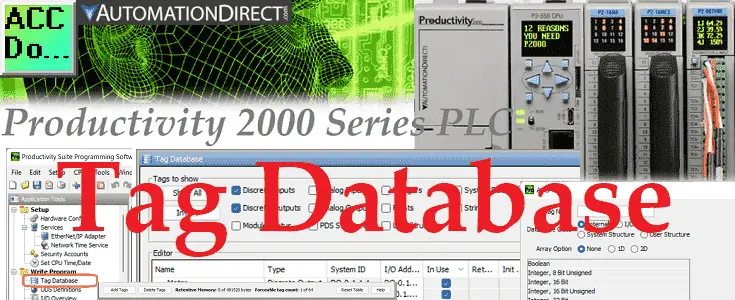The Productivity Suite Software allows us to use tags in the PLC. Tags are a method for assigning and referencing memory locations (numbering systems) within the programmable logic controller. They allow a more structured programming approach and are stored within a tag database. The tag database is stored in the memory of the Productivity Series of PLCs from Automation Direct. Do not overthink tags. Tags are just names assigned to variables of any data type stored in the PLC memory.
 We will now look at the tag numbering systems and database used with the Productivity 2000 controller. Let’s get started.
We will now look at the tag numbering systems and database used with the Productivity 2000 controller. Let’s get started.
Previously in this Productivity 2000 series PLC, we have discussed:
P2000 Hardware Features – Video
Productivity Suite Software Install – Video
Communication (System Configuration) – Video
First Program – Video
Debug Mode – Video
PLC Program Documentation – Video
PLC CPU Display – Video
PLC Online Programming – Video
Data Types – Productivity Numbering Systems
Multiple data types are available for configuring parameters and tags within your automation project. Here is a list of the available types:
– Boolean – True or False, 1 or 0, on or off. These are used for discrete I/O point tag names as well as internal tag names used for logic control.
– Integer, 8 Bit Unsigned – These whole or natural numbers range from 0 to 255. (0 to FF hexadecimal) They are used for numerical tags when only positive variables will be used within a byte boundary.
– Integer, 16 Bit Signed – Range is -32768 to 32767. These are used for numerical tags where variables have the potential for negative or positive values.
– Integer, 16 Bit Unsigned – Range is 0 to 65535. These are used for tags that will only have a positive value.
– Integer, 16 Bit BCD. Unsigned binary coded decimal will have the range of 0 to 9999. These will be used for tags that the decimal numbering system can only represent. 0-9 for each digit.
– Integer, 32 Bit Signed – Range is -2,147,483,648 to 2,147,483,647. This is used as the default for most numeric tags that have the potential for both negative and positive values.
– Integer, 32 Bit BCD. Unsigned binary coded decimal will have the range of 0 to 99,999,999. These will be used for tags that the decimal numbering system can only represent. 0-9 for each digit.
– Float, 32 Bit. This uses the IEEE format floating-point number ranging from -3.39×1038 to 3.39×1038. This data type is for tags that need to be read in this format.
– String. ASCII or test representation allocates one byte (8 bits) per character. These are used for tags that are words when using instructions like ASCII, email, and LCD.
– Constant. This is a fixed value for a numeric or Boolean tag name. Constants can be integers, floating-point or strings. When you enter the constant, the field defined by the data entered assumes the range.
Ex. 1 = 32 bit signed integer, 1.0 = floating-point, A = string
What everybody ought to know about PLC (Programmable Logic Controller) numbering systems is a post that will explain further the meaning behind the above types of numbers.
Tag Database – Productivity Numbering Systems
Open the tag database by clicking on the Tag Database under the Write Program heading in the Application Tools.
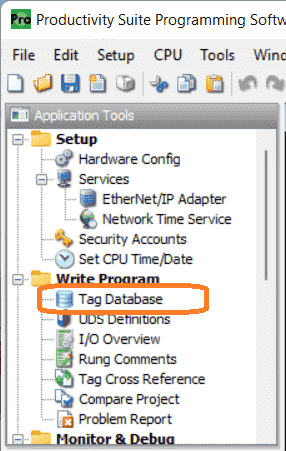 You can also use the main menu | Edit | Tag Database to access the tag database.
You can also use the main menu | Edit | Tag Database to access the tag database.
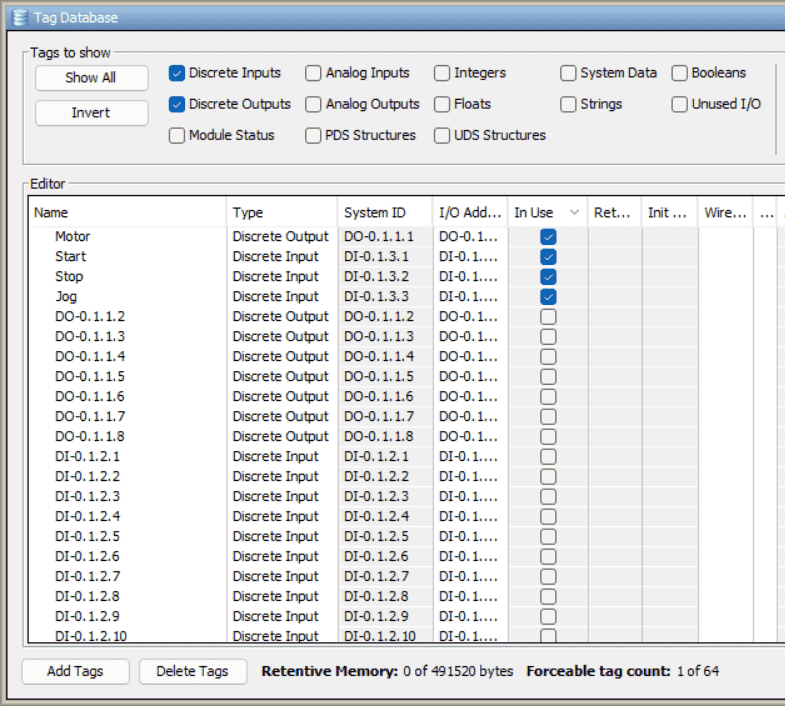
Tags to Show – Productivity Numbering Systems
This upper part of the Tag Database window will help you find the tags and information you require quickly.
 Show All – This will show all of the tags.
Show All – This will show all of the tags.
Invert – This will invert all of the selected tag types. If the input type like Discrete Inputs is checked and you hit the invert button, the tag will be unchecked. If the input type is unchecked and you invert, it will be checked.
The tags will allow you to search the database for a particular name or phase.
 Typing in “jog” in the search tag name will display the tags with this word. It can be part of any of the tags.
Typing in “jog” in the search tag name will display the tags with this word. It can be part of any of the tags.
Editor – Productivity Numbering Systems
The editor has the following columns of information.
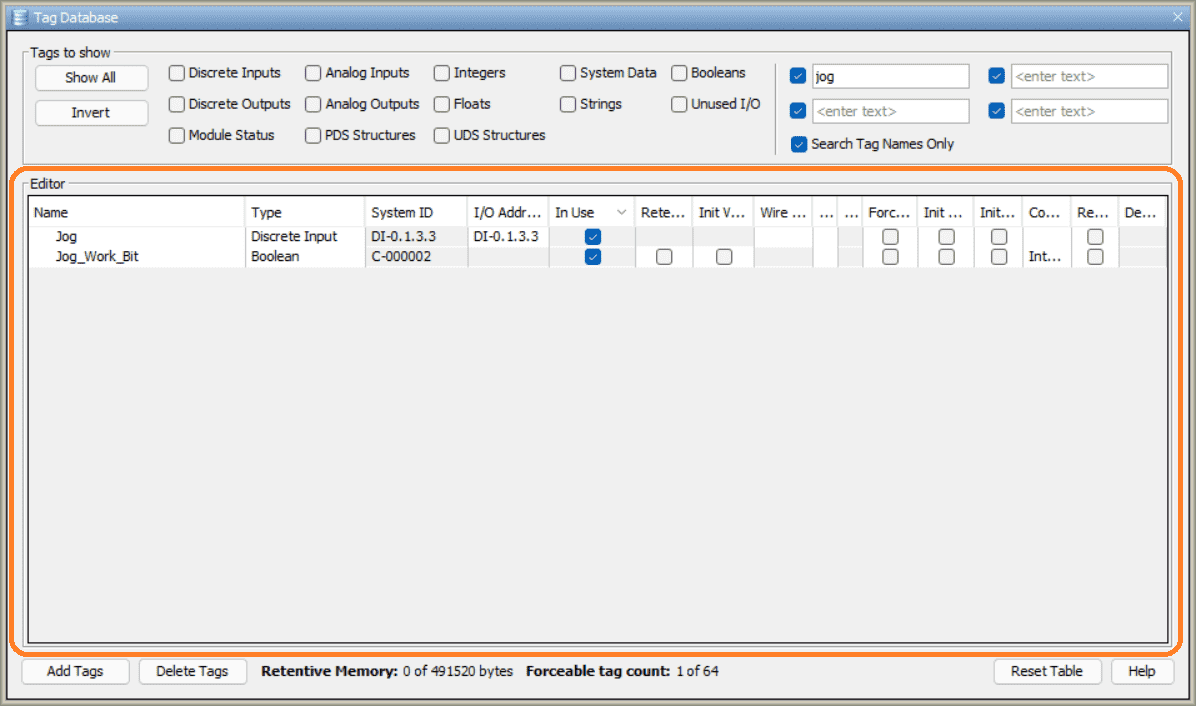 Name – Name was given to the applicable tag
Name – Name was given to the applicable tag
Type – Data type used by the tag
Str Type – Indicates the type of structure used
System ID – Internal ID assigned to user-defined tags
I/O Address – The respective given I/O address
Rows – The number of rows applicable to a 2D Array Data type
Cols – The number of columns relevant to a 1D or 2D Array Data type
Num Chars – The number of Characters applicable to a String Data type
Retentive – The checkbox indicates if the tag is retentive. If power is removed from the PLC, this determines if the information in the tag is retained or not.
Init Value – The value entered in this field will be used for the initial value
Wire Label – Use this field to indicate the wire label information for the I/O point
Mod Start – Optional Modbus Starting Address – We specify what information can be shared on the network through Modbus.
Mod End – Optional Modbus Ending Address
Forcible – This allows the tag to be forced using Data View. A maximum of 64 tags may be selected as enforceable at any time.
Init Forced – Allows the tag to be forced upon start-up from a power cycle or stop/run transition.
Init Forced Value – The value entered in this field will be used for the tag’s value upon an initial force.
Comment – Use this field to add Comments associated with the tag.
Remote Access – Checkbox that indicates the tag can be monitored remotely via the CPU Data Remote Monitor App.
Default Format – Used with integers. Allows data to be viewed in various formats, i.e. decimal, hex, etc.
In Use – Checkbox indicates the tag is used in the ladder diagram.
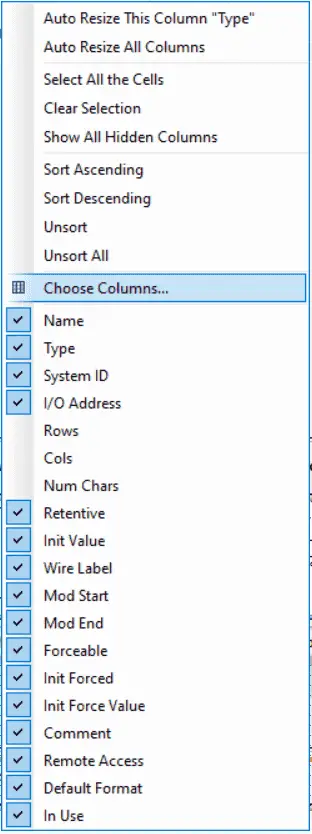 You can auto resize the columns, select, sort, hide or show columns. Right-clicking on the column name will bring up this menu. Select the chosen columns…
You can auto resize the columns, select, sort, hide or show columns. Right-clicking on the column name will bring up this menu. Select the chosen columns…
 This window will provide an easier way to select which items to appear on the tag database editor window.
This window will provide an easier way to select which items to appear on the tag database editor window.
Note: Select and drag the column to another location to arrange the tags the way you see them. You can also resize the width of the column by clicking in between and dragging the width. See the video below.
The bottom of the tag database window gives you the following options:
 Add Tags – We can add tags of any data type. Tags can be made individually or grouped in arrays. We will be discussing arrays and functions later in this series.
Add Tags – We can add tags of any data type. Tags can be made individually or grouped in arrays. We will be discussing arrays and functions later in this series.
Delete Tags – Remove a tag from the tag database.
Reset Table – Restore the table to its original default settings.
Help – Explore the help menu for Tag Database.
Selecting the add tags will call up the add tags window.
 Here you can see all of the different options listed above for your tag type.
Here you can see all of the different options listed above for your tag type.
The tag database allows you to manipulate and view all of the system and personal tags you have developed. Watch the video below to see the numbering systems and tag database in our Productivity 2000 Series PLC.
Download the Productivity 2000 PLC ladder logic program here.
Productivity 2000 Series PLC from Automation Direct
Overview Link (Additional Information on the Unit)
Configuration (Configure and purchase a system – BOM)
User Manual and Inserts (Installation and Setup Guides)
Productivity Suite Overview (Features of the fully functional free software package for the Productivity Family of PLC (PAC) controllers)
Productivity Suite Programming Software (Free Download Link)
This software contains all the instructions and helps files for the Productivity Series.
Watch on YouTube: Productivity 2000 Series PLC Tag Database
If you have any questions or need further information, please contact me.
Thank you,
Garry
If you’re like most of my readers, you’re committed to learning about technology. Numbering systems used in PLCs are not challenging to learn and understand. We will walk through the numbering systems used in PLCs. This includes Bits, Decimal, Hexadecimal, ASCII, and Floating Point.
To get this free article, subscribe to my free email newsletter.
Use the information to inform other people how numbering systems work. Sign up now.
The ‘Robust Data Logging for Free’ eBook is also available for free download. The link is included when you subscribe to ACC Automation.

